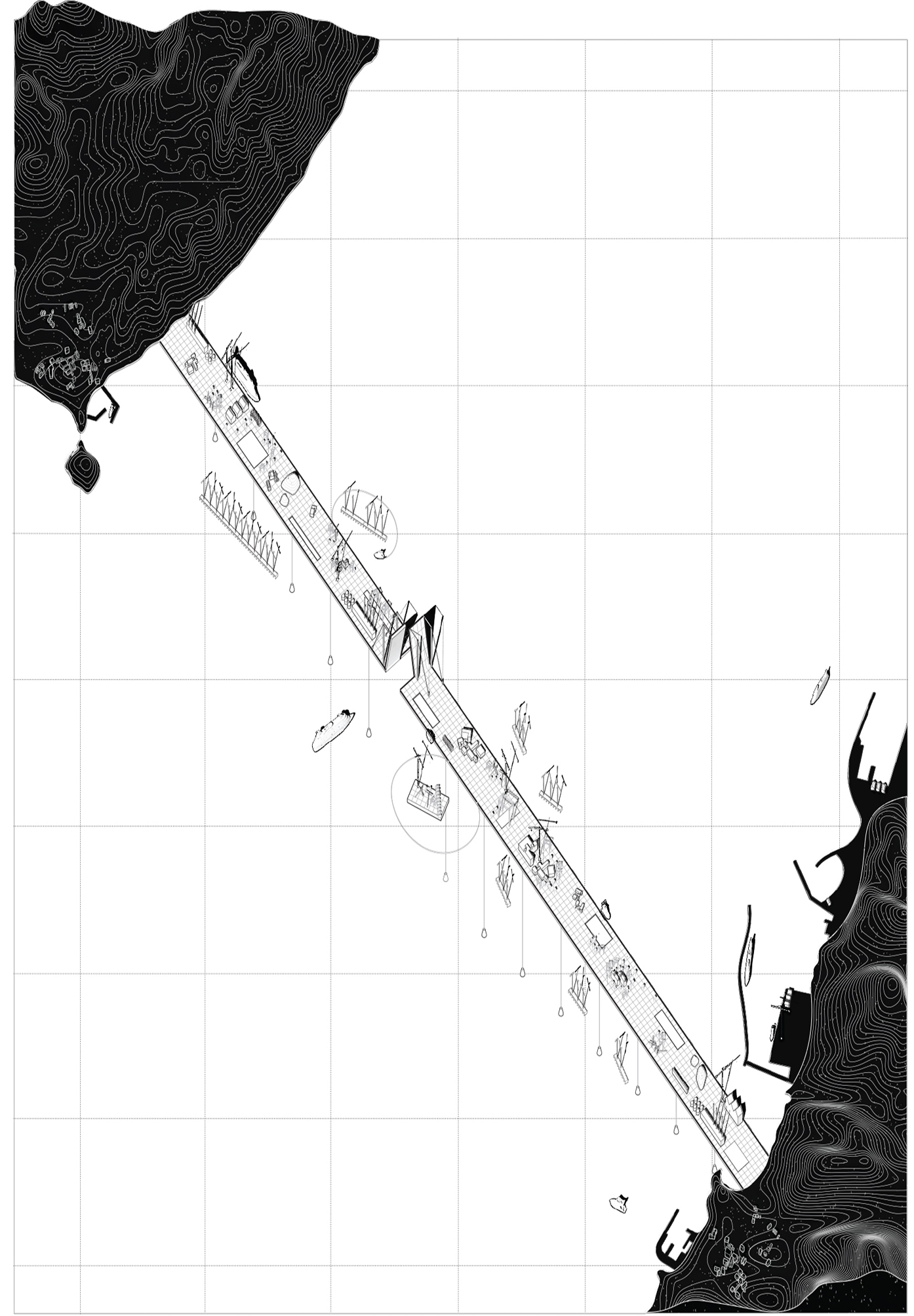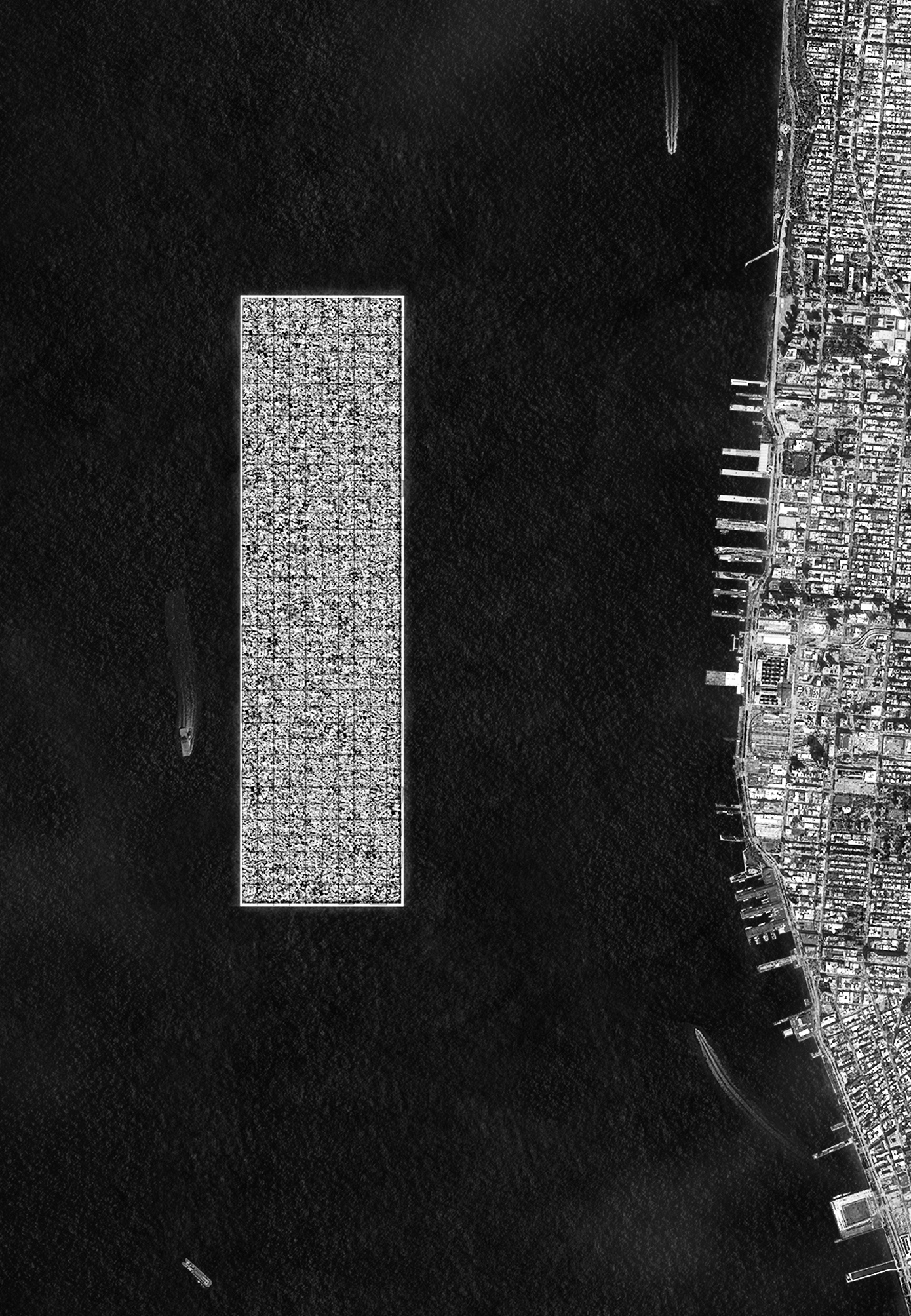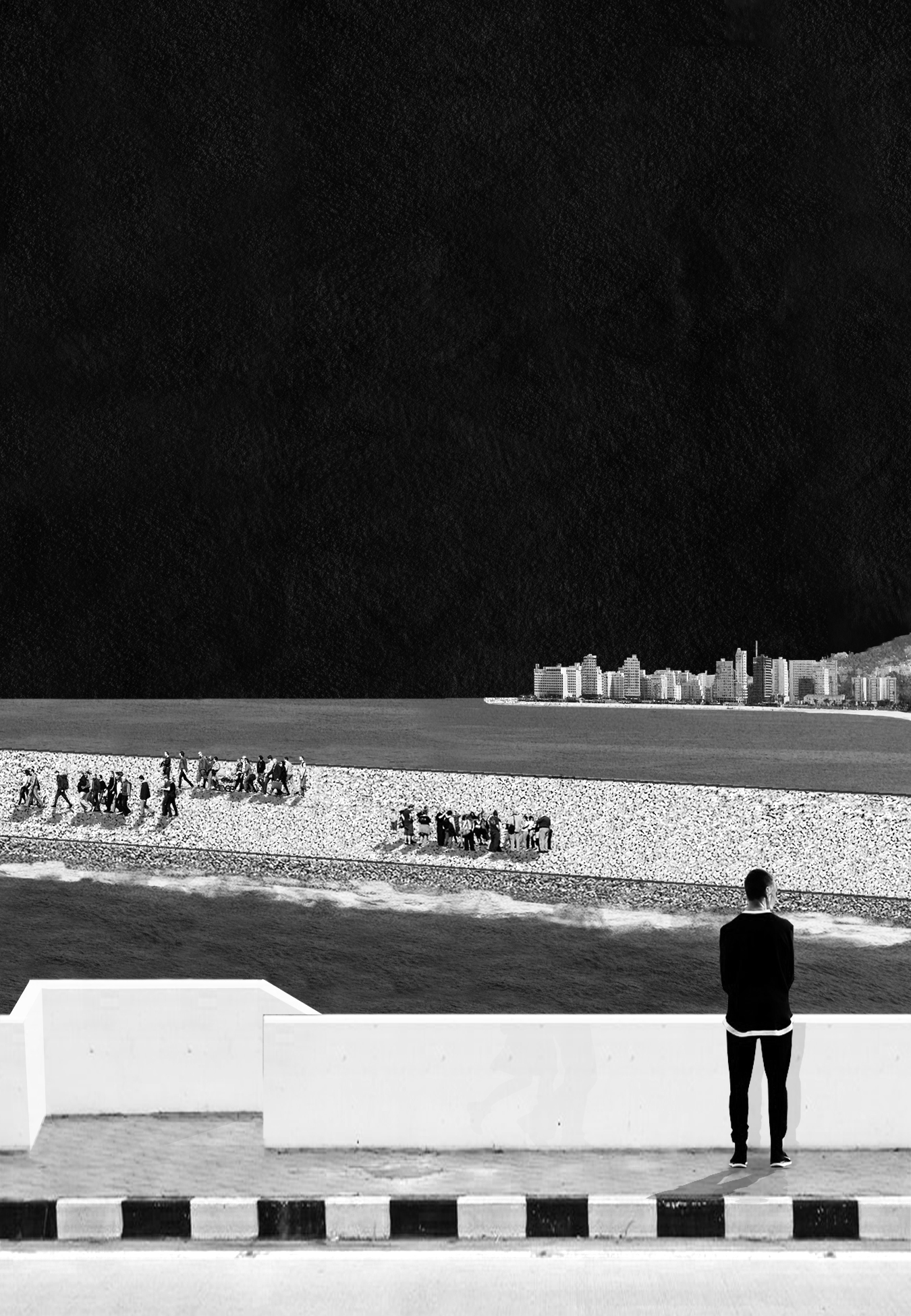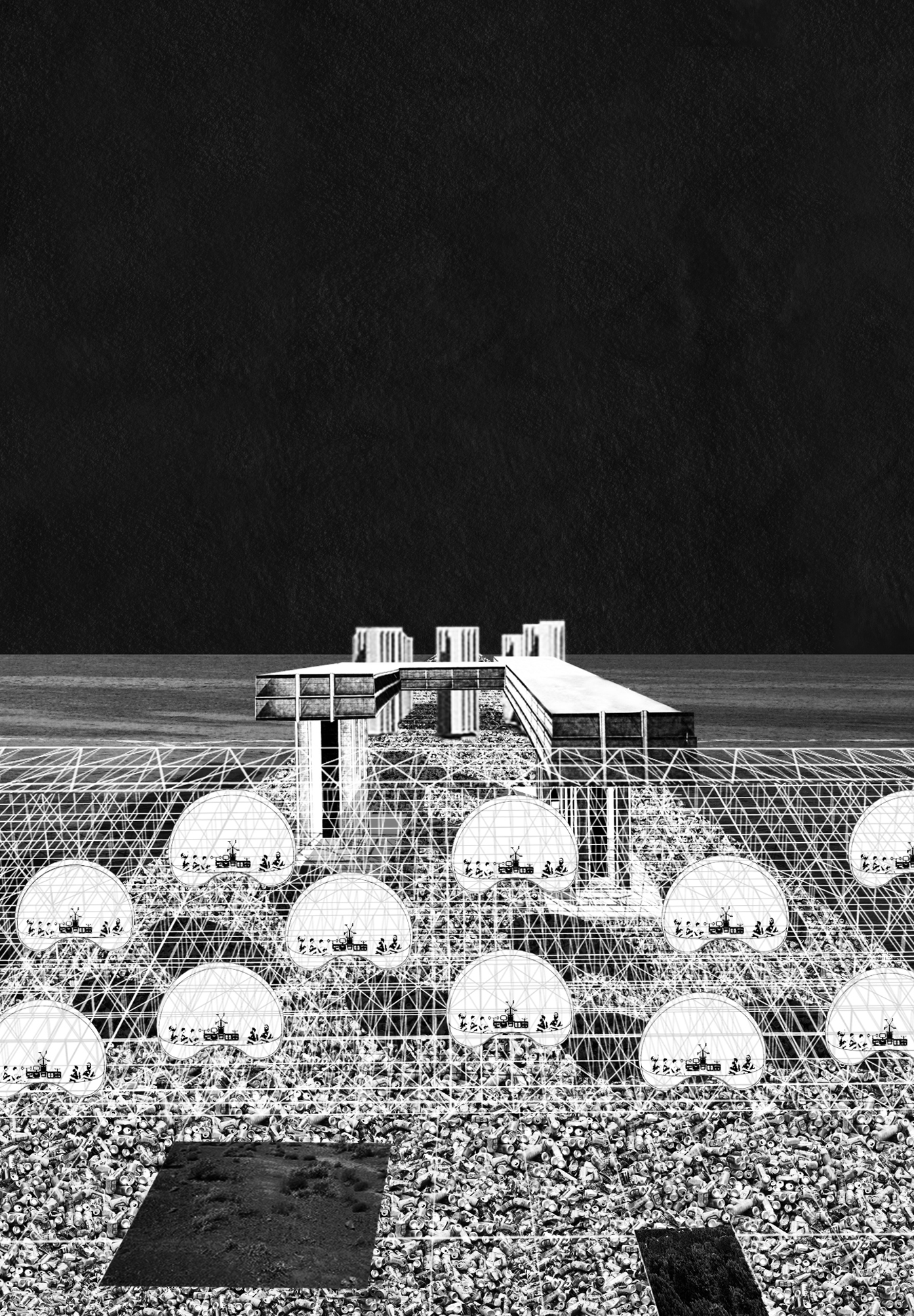Honorable Mention, competition Pamphlet Architecture 36
Team Andrea Gimeno, Lluís J. Liñán, Xevi Lluch, MacAulay Brown Client Pamphlet Architecture Year 2016

RAFT
Despite they remain largely ignored, there are many cities, even entire countries, floating around the Earth. Some of them can barely be seen: the currents dissolve and reshape them, again and again, in unpredictable areas of the infinite surface of the ocean. Others, on the contrary, are shaped by stable currents that keep their contours intact. In both cases, however, their foundations are the same: billions of plastic particles that used to serve the consumption dynamics of human civilization. At some point, they were expelled from it, but their resilience has turned them into an anticipatory relic of the first decades of the Anthropocene.
The EXCITY begins with the harvesting of this pervasive debris. Particle after particle, bag after bottle, what used to be a translucent stain on the surface of the ocean takes the shape of an object with a legible course. After some years following the currents that used to constrain the debris, the object starts to obey its own rules. The more it travels the bigger it gets; fragments from all five oceans adhere to the surface of this precarious raft and increase its autonomy. For many years, its growth remains invisible to the authorities—the raft moves through seas with no label and no one dares to expose the presence of this massive piece of trash. Some years later, the raft has a surface of 4×1 km, and is 5 meters deep; it is twenty times bigger than the largest boat ever built.
One day, it stops. It had been getting closer to the coast for several months, but everyone assumed that it was going to proceed with its harvesting journey. Now, it is a few meters away from the shoreline of a city, proposing a new datum to the horizon. And yet the massive object remains invisible to the eyes of many citizens for weeks; their look is so used to ignore trash that the raft is just perceived as another cargo, just another agent of an infrastructural reality completely alien to their everyday routine. At some point, however, the presence of this massive object becomes too persisent to ignore, as its elevation saturates the vanishing point of all the views that compose their daily commutes. Its details become familiar as well—that can, that bag, had been in their hands not so long ago.
Monumental yet precarious, the raft responds to every action that takes place in the city, or at least that is what the citizens perceive. All the objects that silently used to accompany their activities are now very eloquent about the dynamics that gave birth to their disposal.

BRIDGE
The EXCITY appears to be formless. Framed by the facades of the city, it looks like an unfinished surface made of a heterogeneous collection of dismissed fragments. The line that separates it from the sky seems to move up and down every other day, but it is hard for the residents to tell if this is a product of the tide or a change in the form of the object.
A few kilometers away, so close and yet so distant, the inhabitants of a different continent are ready to respond to this question thanks to the wider perspective provided by a longer distance from the raft. It is not just the tide that moves the garbage up and down, but its form that is changing. After some months of stable presence, the plastic particles now seem to be alive and moving, producing new versions of the object every day. Some say that it is not the plastic that is alive, but the uninterrupted flow of debris thrown into the ocean that keeps the raft growing.
None of this actually matters when the platform stops again. Unlike in its previous version, the raft docks. On both shorelines, actually. It is no longer a raft, but a bridge that connects two cities that, for many years, had refused to look at each other, afraid of seeing their own identity blurred in an unnecessary conversation. Their inability to negotiate renders the power of institutions insignificant compared to the dialectical tension produced by the floating object. Dissatisfied with the role the city has assigned them, many inhabitants decide to move to the other side in search for a better version of their own lives.
Seen from the city, it looks like if the statistic unbalance that exists between both sides of the sea were being rapidly bridged. This time, however, it is people, and not numbers, that visualize the resolution to this equation. Their presence on the coarse surface of the bridge exposes the role that the system gives to a large amount of human beings in order to preserve its efficiency. Too inconvenient to be on the surface, they are relegated to the B-side of reality. The human wave that occupies the bridge reveals the fragility of the present configuration of the city.
Now, the bridge seems to negate its primary function. Instead of crossing it, many people start to settle on it, building precarious structures that protect them from the relentless sun of the summer. They claim that just on top of this strange surface it is truly possible to construct a different version of their life.

EXCITY
Standing on the rooftop of the squared volume that frames the last sector of the EXCITY, some conclusions begin to take shape in the minds of the residents. The stoppage in the urbanization process of the platform provides them with the necessary distance to reflect on the essence of the project that now carries their existence. Some of them recall that a similar awareness made them jump onto the trash-object in the first place: The strangeness of the floating rectangle put their routines on hold, and their willingness to revisit their everyday assumptions acted as a trigger to leave the city behind.
Like all the conversations that take place in the EXCITY, it is hard to differentiate between lively chat and heated discussion. There is a moment, however, when all the words seem to go in the same direction; the most cherished lesson learnt in the construction of the EXCITY is not a regained awareness about the hidden face of their lives, but how it had propelled the emergence of new social relations and a new form of urbanity.
Now, other words distill another conclusion: the initial reaction to their own inability to adapt to the role that the city had assigned to them soon led to an optimistic redefinition of their identity. They had come to understand it as a precarious construction, and not as an imposed image, that had to be constantly adapted to that of their peers. With hindsight, an identity that is porous and willing to be transformed by the different contexts it encounters seems to be more consequent with an era ruled by mobility and total communication.
This last reflection produces a strange moment of total silence. It is just an instant; at the edge of the platform, the citizens realize that they need to keep moving, they need to renew the assumptions that the buildings that colonize the surface of garbage now try to stabilize. The EXCITY needs to be in motion, always. The platform needs to keep navigating the oceans. The citizens need to see their assumptions constantly challenged and redefined by the interaction with other contexts. Architecture needs to be rebuilt as a result of this uninterrupted process of negotiation.

